The global multifunctional household robot market is projected to reach USD 1,461 million by 2035, recording an absolute increase of USD 849.5 million over the forecast period. The market is valued at USD 611.4 million in 2025 and is set to rise at a CAGR of 9% during the assessment period.
The overall market size is expected to grow by nearly 2.39X during the same period, supported by increasing consumer adoption of smart home automation and growing demand for household convenience solutions. However, market growth faces constraints from high initial purchase costs and ongoing concerns about technology complexity among traditional consumer segments.
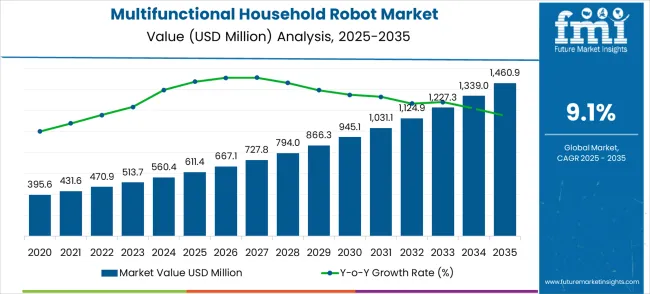
Between 2025 and 2030, the multifunctional household robot market is projected to expand from USD 611.4 million to USD 945.1 million, resulting in a value increase of USD 333.7 million, which represents 39.3% of the total forecast growth for the decade.
This phase of growth will be shaped by rising demand for automated cleaning solutions, product innovation in AI-powered navigation and multi-surface cleaning capabilities, and expanding distribution through consumer electronics retailers and e-commerce platforms.
Companies are establishing competitive positions through investment in advanced sensor technologies, smart home integration capabilities, and strategic market expansion across premium household segments, mid-tier consumer markets, and emerging commercial applications.
From 2030 to 2035, the market is forecast to grow from USD 945.1 million to USD 1,461 million, adding another USD 515.8 million, which constitutes 60.7% of the overall ten-year expansion.
This period is expected to be characterized by the expansion of multifunctional capabilities, including integrated vacuum-mop systems and AI-powered task scheduling tailored for specific household management needs, strategic collaborations between robotics manufacturers and smart home platform providers, and premium positioning with enhanced automation and voice control integration.
The growing emphasis on household efficiency optimization and hands-free cleaning will drive demand for advanced robotic solutions across diverse household types and commercial facility management applications.
| Metric | Value |
|---|---|
| Market Value (2025) | USD 611.4 million |
| Market Forecast Value (2035) | USD 1,461 million |
| Forecast CAGR (2025-2035) | 9% |
The multifunctional household robot market is growing because these devices reduce household labor time while improving cleaning consistency and home maintenance efficiency. Key demand drivers include aging demographics requiring household assistance solutions, dual-income households seeking time-saving automation, increasing smart home technology adoption that integrates robotic systems with home management platforms, and growing consumer acceptance of AI-powered home appliances.
Premium urban households represent the priority segment, while North America and Europe emerge as leading regions due to high disposable income and technology adoption rates. Market growth faces realistic constraints from the high switching costs associated with replacing traditional cleaning methods and consumer concerns about device complexity and maintenance requirements.
The market is segmented by robot type, end-use, and region. By robot type, the market is divided into cleaning housework robots, service housework robots, and others. Based on end-use, the market is categorized into home, commercial, and others. Regionally, the market is divided into North America, Latin America, Europe, East Asia, South Asia & Pacific, and Middle East & Africa.
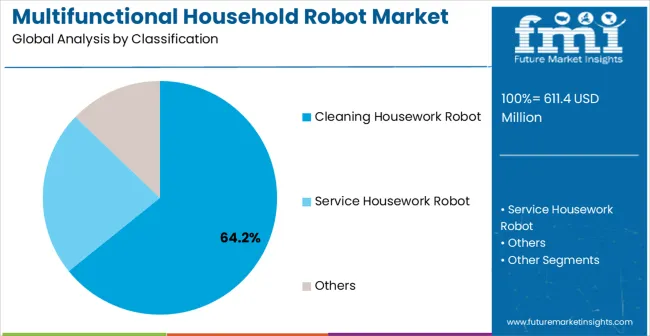
Cleaning housework robots are projected to account for 64.2% of the multifunctional household robot market in 2025, representing the largest share among all robot types. This robust market position is driven by widespread consumer familiarity with automated vacuum cleaners and the growing preference for multi-surface cleaning solutions that combine vacuuming, mopping, and debris collection functions in a single device.
These robots deliver tangible household value by reducing manual labor, saving time, and ensuring consistent cleaning performance across various surfaces. Unlike traditional cleaning methods, they maintain higher hygiene standards, making them particularly appealing to time-conscious and modern households.
Technological advancements significantly contribute to segment growth. Automated navigation systems enable thorough floor coverage with obstacle avoidance and room mapping capabilities, ensuring no area is missed during cleaning. Multi-surface cleaning technology allows effective operation across carpets, hardwood floors, tiles, and other surfaces without manual intervention or adjustments.
Furthermore, smart scheduling and mobile app integration enable households to set personalized cleaning routines that align with family schedules and lifestyle preferences. AI-powered algorithms further optimize cleaning paths, adapt to changing household conditions, and provide real-time monitoring and notifications. These features collectively make cleaning housework robots an indispensable part of modern home maintenance, driving strong adoption across both urban and suburban households globally.
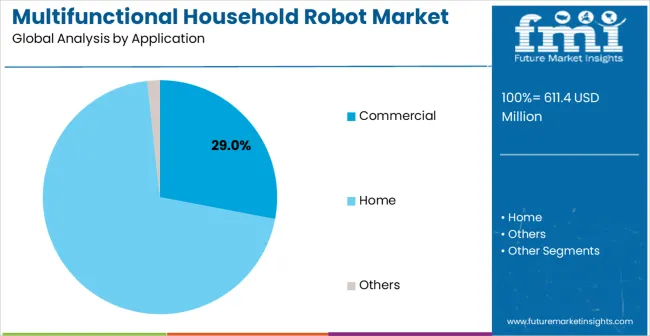
Home applications are expected to represent 72.8% of multifunctional household robot demand in 2025, underscoring the segment’s dominant position in the market. This share reflects a growing consumer preference for automation solutions that offer direct personal convenience and enhance lifestyle efficiency.
Modern households increasingly adopt these robots to reduce the burden of daily chores, maintain consistent home hygiene, and free up time for family, leisure, and professional activities. The convenience of automated cleaning and household management makes these robots highly appealing, particularly for busy families, working professionals, and tech-savvy consumers.
Residential adoption is further facilitated by the ability of consumers to make direct purchasing decisions without institutional approval processes or budget constraints. Integrating household robots into daily routines significantly improves family lifestyle by reducing cleaning time, ensuring consistent maintenance, and allowing households to focus on more meaningful tasks.
Market growth is also supported by consumer education campaigns, word-of-mouth recommendations, and positive demonstrations from early adopters, who highlight productivity and lifestyle benefits to their networks. As awareness of robotic solutions continues to expand and households recognize measurable improvements in efficiency and convenience, the home applications segment is projected to maintain its leadership position and continue driving the multifunctional household robot market forward.
The multifunctional household robot market is propelled by several key drivers that reflect evolving consumer needs and lifestyle dynamics. Aging population demographics represent a significant demand driver, as older adults increasingly seek household assistance solutions that allow them to maintain independent living while reducing physical strain associated with routine cleaning tasks.
These robots offer a practical solution by automating repetitive chores, enabling seniors to preserve mobility and autonomy in their homes. The growth of dual-income households further accelerates market demand, as working families require time-saving automation that improves household management efficiency, reduces domestic labor burdens, and supports better work-life balance.
In addition, the expansion of smart home ecosystems enhances the appeal of multifunctional household robots. Integration with other automated home systems, such as smart lighting, security, and HVAC controls, allows robotic systems to coordinate tasks intelligently, delivering optimized efficiency and convenience for modern households.
Despite these drivers, the market faces several restraints that may limit adoption. High upfront costs of multifunctional household robots present a barrier for price-sensitive consumers, while the complexity of technology and perceived difficulty in operating these systems may deter traditional households unfamiliar with robotic devices.
Ongoing maintenance requirements also pose challenges, as regular servicing and component replacements can add to household responsibilities. Additionally, consumer skepticism regarding robot effectiveness compared to manual cleaning methods necessitates extensive demonstrations, education campaigns, and trust-building initiatives to shift entrenched cleaning habits.
Key trends indicate a strong adoption trajectory in urban premium households and among aging populations, where automation provides tangible lifestyle benefits and independence. Product design is evolving toward multi-functional integration, voice control capabilities, and predictive cleaning scheduling, making these robots more intuitive and appealing to a wider range of consumers.
These advancements justify premium pricing by delivering comprehensive household value. However, the market remains sensitive to potential disruptions, such as traditional cleaning methods achieving similar automation benefits or economic downturns reducing discretionary spending on household appliances. The market is poised for steady growth, driven by lifestyle convenience, technological integration, and the evolving demands of modern households.
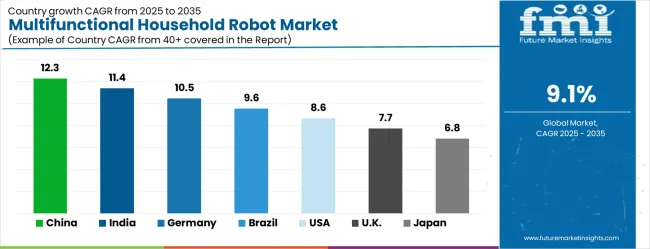
| Country | CAGR (2025-2035) |
|---|---|
| China | 12.3% |
| India | 11.4% |
| Germany | 10.5% |
| Brazil | 9.6% |
| United States | 8.6% |
| United Kingdom | 7.7% |
| Japan | 6.8% |
The multifunctional household robot market is gathering pace worldwide, with China taking the lead thanks to rapid smart home adoption and manufacturing cost advantages. Close behind, India benefits from growing middle-class prosperity and increasing awareness of household automation benefits, positioning itself as a strategic growth hub.
Germany shows steady advancement, where engineering excellence and premium appliance preferences strengthen its role in the regional supply chain. Brazil is sharpening focus on household convenience solutions and emerging technology adoption, signaling an ambition to capture niche opportunities.
Meanwhile, the United States stands out for its established consumer electronics market, and the United Kingdom and Japan continue to record consistent progress. Together, China and India anchor the global expansion story, while the rest build stability and diversity into the market's growth path.
The report covers an in-depth analysis of 40+ countries; the top-performing countries are highlighted below.
China is at the forefront of the global multifunctional household robot market, demonstrating the strongest growth potential due to its advanced manufacturing infrastructure and the rapid expansion of smart home ecosystems across major urban centers. The market is projected to grow at a CAGR of 12.3% through 2035, driven by increasing adoption of household automation in cities such as Beijing, Shanghai, and Guangzhou.
Rising disposable incomes, urban lifestyle pressures, and the growing desire for convenience are motivating consumers to integrate multifunctional robots into their homes. These robots are increasingly viewed as essential components of smart home systems, providing seamless coordination with security platforms, lighting systems, climate control devices, and other connected household technologies.
The popularity of AI-powered appliances ensures that multifunctional household robots are not only performing traditional cleaning and maintenance tasks but also contributing to energy optimization and lifestyle enhancement.
Strong domestic manufacturing capabilities allow companies to produce advanced robotic technologies cost-effectively, ensuring competitive pricing while maintaining high quality and innovation. Additionally, e-commerce platforms and live-streaming channels facilitate product education and rapid consumer adoption, enabling nationwide market penetration across urban and suburban households.
India is emerging as a high-potential market for multifunctional household robots, driven by rising disposable incomes, urbanization, and growing consumer interest in modern household technologies. In metropolitan hubs such as Mumbai and Delhi, affluent urban families are increasingly adopting household robots to enhance domestic efficiency, reduce manual labor, and optimize daily household management.
The market is projected to expand at a CAGR of 11.4% through 2035, reflecting the rising spending power of middle- and upper-class households, greater exposure to international household technology trends, and an increasing focus on lifestyle enhancement. Indian consumers perceive multifunctional robots not only as practical domestic helpers but also as investments in privacy, convenience, and household control.
Access to international robotics brands is improving through online retail platforms and consumer electronics stores, which introduce advanced technologies that were previously unavailable in traditional appliance markets. As households become more aware of the functional and lifestyle benefits of robotic solutions, adoption is expected to accelerate, particularly in urban centers where time-saving and automation are highly valued.
Germany represents a key market for multifunctional household robots in Europe, characterized by a strong preference for engineering precision, durability, and premium appliance standards. Consumer adoption is particularly concentrated in major urban centers such as Munich, Hamburg, and Berlin, where households demonstrate high awareness of technology quality, reliability, and long-term performance.
The German market is projected to grow at a CAGR of 10.5% through 2035, reflecting both the willingness of consumers to invest in high-quality home automation solutions and the country’s established reputation for engineering excellence. German consumers expect household robots to meet strict performance and reliability criteria, aligning with broader expectations for premium household appliances.
This focus on quality over cost ensures that multifunctional household robots are designed for efficiency, durability, and seamless integration with other smart home systems. Additionally, partnerships between domestic appliance manufacturers and international robotics companies are fostering technological innovation, enabling robots to incorporate advanced navigation, multi-surface cleaning capabilities, and AI-driven functionalities. As awareness of automation benefits grows, particularly among premium households seeking convenience, efficiency, and lifestyle enhancement, Germany is poised to remain a central hub for European market growth.
Brazil is experiencing steady growth in the multifunctional household robot market, driven by urban development, rising disposable incomes, and the modernization of household practices. Key metropolitan regions such as São Paulo, Rio de Janeiro, and Brasília are leading adoption, where affluent households and dual-income families increasingly seek solutions that enhance household efficiency and reduce manual labor.
The market is supported by broader modernization trends, with traditional cleaning practices gradually giving way to automated assistance, reflecting changing consumer lifestyles and a willingness to invest in convenience-driven technologies. Multifunctional household robots are being adopted not only for cleaning purposes but also as part of a broader household management ecosystem, helping families optimize time and improve domestic productivity.
Market growth, however, faces challenges related to consumer education and awareness. Many households require guidance on robot capabilities, integration with existing routines, and demonstration of tangible benefits. Retail expansion, online platforms, and targeted marketing campaigns are key strategies enabling consumers to better understand product functionality, fostering adoption among urban middle-class households seeking lifestyle and time-saving improvements.
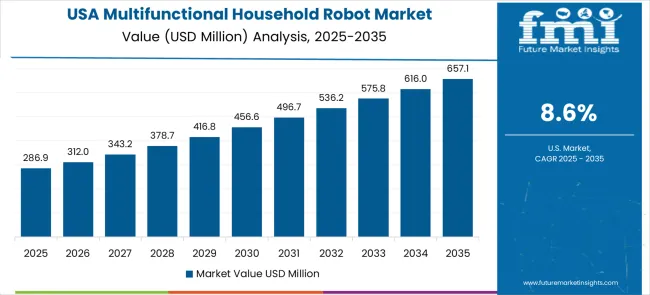
The United States is a leading market for multifunctional household robots, characterized by strong consumer demand for advanced automation solutions that deliver measurable time savings, consistent cleaning performance, and long-term reliability.
Market growth is projected at a CAGR of 8.6% through 2035, driven by increasing adoption among dual-income households, tech-savvy urban families, and premium consumers seeking household efficiency and lifestyle optimization.
American consumers prioritize multifunctional household robots that seamlessly integrate with existing smart home platforms, including voice assistants, lighting, security, and climate control systems, allowing for coordinated and intelligent household management. This focus on integration, coupled with high expectations for performance and safety, positions the USA market as a leader in innovation and technological adoption.
Consumer electronics retailers and online platforms play a critical role by expanding product availability, offering technical support, and educating consumers on features, benefits, and comparisons among robotic systems. The emphasis on compliance with safety and performance standards ensures that these robots are not only efficient but also reliable and safe for daily household use, particularly in homes with children or elderly residents.
The United Kingdom represents a medium-growth market for multifunctional household robots, characterized by steady consumer adoption and well-established distribution networks. The market is projected to grow at a CAGR of 7.7%, reflecting gradual but consistent acceptance of household automation solutions across a range of demographic segments.
Urban professionals and aging households form the primary adopters, seeking products that reduce daily cleaning workloads, improve household efficiency, and enhance lifestyle convenience. UK consumers demonstrate a balanced approach, combining awareness of technological benefits with practical considerations such as performance reliability, ease of use, and long-term value. Household robots are increasingly integrated into existing home management routines, complementing conventional cleaning practices while delivering measurable improvements in time savings, consistency, and overall household maintenance.
Mature distribution channels, including consumer electronics retailers and online platforms, facilitate access to a wide range of domestic and international robotic solutions, supporting product education and adoption. The growing integration of smart home systems further enhances the utility of these robots, allowing households to coordinate cleaning, security, and energy management functions seamlessly, thereby reinforcing the market’s steady growth trajectory.
Key Market Drivers and Trends:
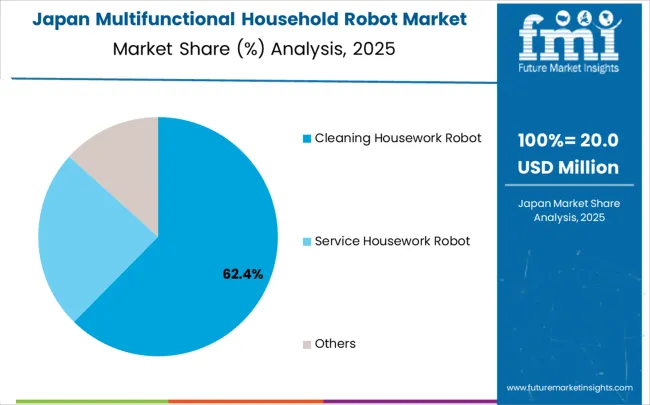
Japan represents one of the most mature markets for multifunctional household robots, characterized by highly sophisticated consumers and widespread awareness of household automation technologies. Market growth is projected at a CAGR of 6.8%, reflecting a scenario where purchasing decisions are heavily influenced by quality, reliability, and advanced functionality rather than price sensitivity.
Japanese households prioritize household robots that deliver exceptional engineering precision, seamless integration with home systems, and consistent long-term performance, justifying investment in premium appliances. The culture of household efficiency in Japan drives informed adoption decisions, where consumers assess measurable productivity gains, reliability, and practical benefits over convenience-oriented marketing claims.
Advanced technological integration, including precision navigation, AI-assisted cleaning, and multi-surface adaptability, enables household robots to meet these exacting standards. Additionally, smart home leadership in Japan ensures that robotic systems can coordinate with other connected devices, supporting comprehensive household automation and enhancing daily living efficiency. These factors collectively reinforce Japan’s position as a global leader in the multifunctional household robot market, where innovation, quality, and performance are key adoption drivers.
Key Market Drivers and Trends:
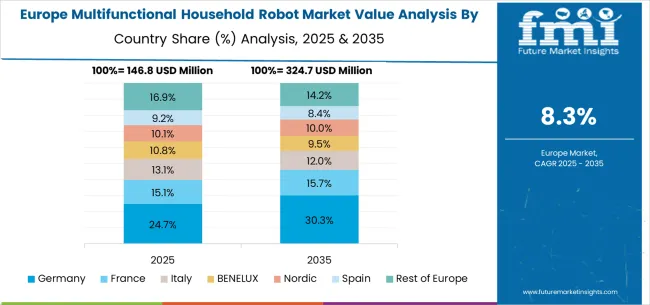
The European multifunctional household robot market represents a mature regional ecosystem where established consumer awareness and premium appliance preferences drive steady adoption across diverse national markets.
Northern European countries including Germany and the United Kingdom provide technology leadership through engineering excellence and quality standards that influence product development across the broader European market. These markets establish performance benchmarks and consumer expectation standards that drive innovation in household automation and robotic system integration.
Central European markets demonstrate growing interest in household efficiency solutions as disposable income supports premium appliance investments and urban lifestyles favor automated household management.
Southern European markets show increasing adoption of household technology as traditional household management practices incorporate modern automation solutions. The regional integration enables technology sharing, distribution efficiency, and consumer education programs that accelerate market development across diverse cultural and economic contexts.
The multifunctional household robot market exhibits moderate fragmentation, with approximately 20-25 significant players competing globally. Market concentration remains relatively dispersed, with the top five companies controlling roughly 40-45% of the total market value. Competition style emphasizes technology differentiation, household performance validation, and consumer education rather than traditional price competition, as consumers prioritize effectiveness and reliability when investing in household automation solutions.
Market leaders, including iRobot, Samsung, and Dyson, maintain competitive advantages through established brand recognition, proven technology platforms, and comprehensive distribution networks that enable global market reach. These companies leverage superior R&D capabilities, patent portfolios, and manufacturing scale to develop advanced features, including AI-powered navigation, multi-surface cleaning optimization, and smart home ecosystem integration. Their market positions benefit from consumer trust in household appliance reliability and established relationships with consumer electronics retailers who recommend specific products for household automation needs.
Technology Challengers: Panasonic, LG, and ECOVACS compete through specialized technology development, competitive pricing strategies, and targeted market segment focus that challenge established players in specific geographic regions or consumer demographics. These companies often lead in innovative feature development, advanced sensor integration, and cost-effective manufacturing that make sophisticated household automation accessible to broader consumer segments.
Specialist Providers: Moley Robotics, Roborock, NARWAL, Dreame, Xiaomi, and Midea serve specific market niches through focused product development, regional market expertise, and competitive pricing strategies that appeal to cost-conscious consumers seeking effective household automation without premium brand pricing. These companies contribute market diversity through alternative technology approaches, specialized application focus, and flexible customization capabilities that address unique household requirements and regional preferences.
The multifunctional household robot market represents a transformative shift in domestic automation, evolving from single-purpose devices to AI-powered platforms capable of cleaning, cooking, monitoring, and providing companionship. With the market expanding from USD 611.4 million to a projected USD 1,461 million at 9% CAGR, success depends on coordinated efforts across regulatory bodies, technology ecosystems, manufacturing networks, service providers, and investment communities to address infrastructure readiness, consumer adoption barriers, and technical standardization challenges.
Consumer Safety & Standards Framework: Establish comprehensive certification protocols for AI-enabled home robots covering data privacy, physical safety, electromagnetic compatibility, and cybersecurity requirements. Create clear liability frameworks for autonomous household operations and robot-human interactions.
Smart Home Infrastructure Investment: Subsidize fiber broadband expansion and 5G coverage in residential areas to support cloud-connected robotics. Invest in smart grid infrastructure that can handle increased electricity demand from charging stations and always-on connected devices.
R&D Tax Incentives: Provide enhanced tax credits for companies developing advanced navigation systems, natural language processing, computer vision, and multi-modal AI specifically for domestic applications. Fund university research programs focusing on human-robot interaction and elderly care robotics.
Regulatory Sandboxes: Create testing zones where companies can deploy advanced household robots with relaxed regulations to gather real-world performance data while maintaining safety oversight. Establish fast-track approval pathways for assistive robots serving aging populations.
Trade & Import Policies: Reduce tariffs on critical components like LiDAR sensors, advanced batteries, and AI processing chips to lower manufacturing costs. Negotiate mutual recognition agreements for robot safety certifications with key manufacturing countries.
Interoperability Standards: Develop universal communication protocols enabling robots from different manufacturers to coordinate tasks and share environmental mapping data within smart home ecosystems. Establish common APIs for integration with home automation platforms.
Performance Benchmarking: Create standardized testing methodologies for cleaning efficiency, navigation accuracy, battery life, and AI responsiveness that allow consumers to compare products objectively across brands and price points.
Skills Taxonomy & Training: Define competency frameworks for robot technicians, installation specialists, and customer support teams. Develop certification programs that ensure consistent service quality as the market scales beyond early adopters.
Market Education Initiatives: Lead consumer awareness campaigns addressing privacy concerns, realistic performance expectations, and total cost of ownership, including maintenance, software updates, and consumables replacement.
Ethical AI Guidelines: Establish industry codes of conduct for data collection, algorithmic decision-making, and personalization features that build consumer trust while enabling innovation in predictive household management.
How OEMs and Technology Integrators Could Strengthen the Ecosystem?
Modular Platform Architecture: Design robot platforms with swappable modules for different tasks (vacuum/mop combinations, cooking attachments, security sensors) enabling consumers to customize functionality without purchasing multiple specialized devices.
Edge AI Optimization: Develop lightweight AI models that can run locally on robot processors, reducing cloud dependency for basic operations while maintaining connectivity for advanced features and continuous learning.
Advanced Sensor Fusion: Integrate multiple sensing technologies - computer vision, ultrasonic, infrared, and tactile sensors - to enable safe navigation around pets, children, and delicate household items while maintaining cleaning thoroughness.
Predictive Maintenance Systems: Build self-diagnostic capabilities that predict component failures, optimize cleaning schedules based on usage patterns, and automatically order replacement parts to minimize downtime.
Human-Robot Interface Innovation: Advance natural language processing, gesture recognition, and contextual awareness to make robot interaction intuitive for users across different age groups and technical comfort levels.
How Service Providers and Retailers Could Navigate Market Evolution?
Installation & Setup Services: Offer comprehensive home assessment, Wi-Fi optimization, and robot configuration services that ensure optimal performance from day one, particularly important for elderly users and complex home layouts.
Subscription Service Models: Develop recurring revenue streams through cleaning supply deliveries, software feature updates, extended warranties, and regular maintenance visits that improve unit economics and customer lifetime value.
Data-Driven Personalization: Use aggregated cleaning patterns and user preferences to optimize robot behavior, predict maintenance needs, and recommend complementary smart home products while respecting privacy boundaries.
Multi-Brand Service Networks: Establish authorized service networks that can support multiple robot brands, enabling geographic coverage and scaling technical expertise necessary for mainstream market penetration.
Trade-In & Upgrade Programs: Establish programs for upgrading older robots to newer models, refurbishing returned units for budget-conscious consumers, and properly recycling end-of-life devices containing batteries and electronic components.
Manufacturing Scale-Up Capital: Finance automated production facilities and component supply chain investments needed to reduce unit costs from premium pricing to mass-market accessibility, particularly in key manufacturing regions.
Technology Development Funding: Back startups advancing breakthrough technologies in battery efficiency, cost-effective sensors, specialized cleaning mechanisms, and AI algorithms that differentiate products in an increasingly competitive market.
Consumer Financing Solutions: Partner with retailers and manufacturers to offer flexible payment plans, lease-to-own programs, and insurance products that make higher-priced multifunctional robots accessible to broader consumer segments.
Supply Chain Resilience Investment: Support diversification of component sourcing, local assembly capabilities, and inventory management systems that can withstand global supply chain disruptions affecting semiconductor and battery availability.
Market Expansion Vehicles: Fund companies targeting underserved segments, such as assisted living facilities, small commercial spaces, and emerging markets where household robot adoption is accelerating rapidly but requires different product configurations and business models.
| Item | Value |
|---|---|
| Quantitative Units (2025) | USD 611.4 million |
| Robot Type | Cleaning Housework Robot, Service Housework Robot, Others |
| End-Use | Home, Commercial, Others |
| Regions Covered | North America, Latin America, Europe, East Asia, South Asia & Pacific, Middle East & Africa |
| Country Covered | United States, Canada, United Kingdom, Germany, France, China, Japan, South Korea, India, Brazil, Australia and 40+ countries |
| Key Companies Profiled | iRobot, Samsung, Dyson, Panasonic, LG, Moley Robotics, ECOVACS, Roborock, NARWAL, Dreame, Xiaomi, Midea |
| Additional Attributes | Dollar sales by robot type and end-use applications, regional household automation trends across North America, Europe, and Asia-Pacific, competitive landscape with established appliance manufacturers and emerging robotics specialists, consumer adoption patterns for premium versus entry-level household automation systems, integration with smart home platforms and voice control systems, innovations in AI-powered navigation and multi-surface cleaning optimization, and development of subscription service models with comprehensive household management programs. |
North America
Europe
East Asia
South Asia & Pacific
Latin America
Middle East & Africa
The global multifunctional household robot market is estimated to be valued at USD 611.4 million in 2025.
The market size for the multifunctional household robot market is projected to reach USD 1,460.9 million by 2035.
The multifunctional household robot market is expected to grow at a 9.1% CAGR between 2025 and 2035.
The key product types in multifunctional household robot market are cleaning housework robot, service housework robot and others.
In terms of application, commercial segment to command 0.0% share in the multifunctional household robot market in 2025.






Our Research Products

The "Full Research Suite" delivers actionable market intel, deep dives on markets or technologies, so clients act faster, cut risk, and unlock growth.

The Leaderboard benchmarks and ranks top vendors, classifying them as Established Leaders, Leading Challengers, or Disruptors & Challengers.

Locates where complements amplify value and substitutes erode it, forecasting net impact by horizon

We deliver granular, decision-grade intel: market sizing, 5-year forecasts, pricing, adoption, usage, revenue, and operational KPIs—plus competitor tracking, regulation, and value chains—across 60 countries broadly.

Spot the shifts before they hit your P&L. We track inflection points, adoption curves, pricing moves, and ecosystem plays to show where demand is heading, why it is changing, and what to do next across high-growth markets and disruptive tech

Real-time reads of user behavior. We track shifting priorities, perceptions of today’s and next-gen services, and provider experience, then pace how fast tech moves from trial to adoption, blending buyer, consumer, and channel inputs with social signals (#WhySwitch, #UX).

Partner with our analyst team to build a custom report designed around your business priorities. From analysing market trends to assessing competitors or crafting bespoke datasets, we tailor insights to your needs.
Supplier Intelligence
Discovery & Profiling
Capacity & Footprint
Performance & Risk
Compliance & Governance
Commercial Readiness
Who Supplies Whom
Scorecards & Shortlists
Playbooks & Docs
Category Intelligence
Definition & Scope
Demand & Use Cases
Cost Drivers
Market Structure
Supply Chain Map
Trade & Policy
Operating Norms
Deliverables
Buyer Intelligence
Account Basics
Spend & Scope
Procurement Model
Vendor Requirements
Terms & Policies
Entry Strategy
Pain Points & Triggers
Outputs
Pricing Analysis
Benchmarks
Trends
Should-Cost
Indexation
Landed Cost
Commercial Terms
Deliverables
Brand Analysis
Positioning & Value Prop
Share & Presence
Customer Evidence
Go-to-Market
Digital & Reputation
Compliance & Trust
KPIs & Gaps
Outputs
Full Research Suite comprises of:
Market outlook & trends analysis
Interviews & case studies
Strategic recommendations
Vendor profiles & capabilities analysis
5-year forecasts
8 regions and 60+ country-level data splits
Market segment data splits
12 months of continuous data updates
DELIVERED AS:
PDF EXCEL ONLINE
Multifunctional Loader Market Size and Share Forecast Outlook 2025 to 2035
Multifunctional Printer Market Size and Share Forecast Outlook 2025 to 2035
Multifunctional Adhesive Tape Market Analysis - Size, Share, and Forecast Outlook 2025 to 2035
Analysis and Growth Projections for Multifunctional Food Ingredient Business
Intelligent Multifunctional Laser Bird Repeller Market Size and Share Forecast Outlook 2025 to 2035
Household R290 Air Conditioner Market Size and Share Forecast Outlook 2025 to 2035
Household Kitchen Appliances Market Size and Share Forecast Outlook 2025 to 2035
Household Care Wipes Market Size and Share Forecast Outlook 2025 to 2035
Household Refrigerators and Freezers Market Analysis - Size, Share, & Forecast Outlook 2025 to 2035
Household Water Dispensers Market Analysis by Growth, Trends and Forecast from 2025 to 2035
Household Appliances Market Trends – Growth & Forecast 2025 to 2035
Household & Cleaning Container Market
Household Aluminum Foil Market
Household Robot Market Insights – Growth & Forecast 2024-2034
Robot Controller, Integrator and Software Market Size and Share Forecast Outlook 2025 to 2035
Robotic Warfare Market Size and Share Forecast Outlook 2025 to 2035
Robotic Lawn Mower Market Size and Share Forecast Outlook 2025 to 2035
Robotics Welding Market Size and Share Forecast Outlook 2025 to 2035
Robotic Rehab Tools Market Analysis - Size, Share, and Forecast Outlook 2025 to 2035
Robotics-Assisted Telesurgery Market Size and Share Forecast Outlook 2025 to 2035

Thank you!
You will receive an email from our Business Development Manager. Please be sure to check your SPAM/JUNK folder too.
Chat With
MaRIA